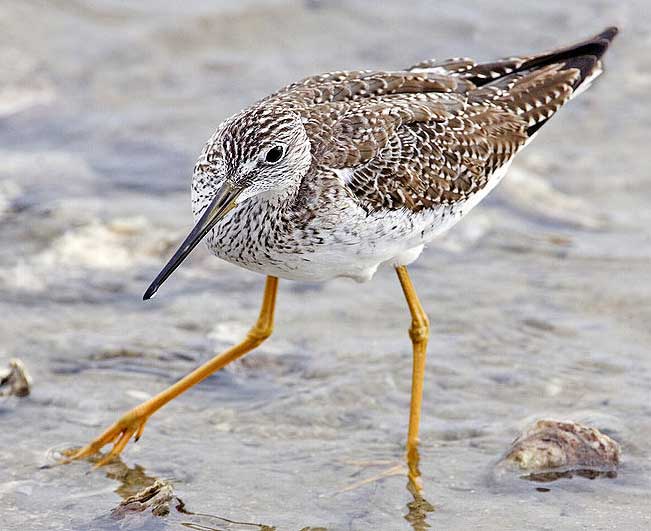
Tringa flavipes (*)
Superregnum: Eukaryota
Regnum: Animalia
Subregnum: Eumetazoa
Cladus: Bilateria
Cladus: Nephrozoa
Superphylum: Deuterostomia
Phylum: Chordata
Subphylum: Vertebrata
Infraphylum: Gnathostomata
Megaclassis: Osteichthyes
Superclassis: Sarcopterygii
Superclassis: Tetrapoda
Cladus: Reptiliomorpha
Cladus: Amniota
Classis: Reptilia
Cladus: Eureptilia
Cladus: Romeriida
Subclassis: Diapsida
Cladus: Sauria
Infraclassis: Archosauromorpha
Cladus: Crurotarsi
Divisio: Archosauria
Cladus: Avemetatarsalia
Cladus: Ornithodira
Subtaxon: Dinosauromorpha
Cladus: Dinosauriformes
Cladus: Dracohors
Cladus: Dinosauria
Ordo: Saurischia
Cladus: Eusaurischia
Cladus: Theropoda
Cladus: Neotheropoda
Cladus: Averostra
Cladus: Tetanurae
Cladus: Avetheropoda
Cladus: Coelurosauria
Cladus: Tyrannoraptora
Cladus: Maniraptoromorpha
Cladus: Maniraptoriformes
Cladus: Maniraptora
Cladus: Pennaraptora
Cladus: Paraves
Cladus: Eumaniraptora
Cladus: Avialae
Infraclassis: Aves
Cladus: Euavialae
Cladus: Avebrevicauda
Cladus: Pygostylia
Cladus: Ornithothoraces
Cladus: Euornithes
Cladus: Ornithuromorpha
Cladus: Ornithurae
Cladus: Carinatae
Parvclassis: Neornithes
Cohors: Neognathae
Cladus: Neoaves
Ordo: Charadriiformes
Subordo: Charadrii
Familia: Scolopacidae
Genus: Tringa
Species: Tringa flavipes
Name
Tringa flavipes (Gmelin, 1789)
Synonyms
Scolopax flavipes (protonym)
References
Systema Naturae 1 (2): 659.
Vernacular names
Afrikaans: Kleingeelpootruiter
brezhoneg: Strelleg bihan pavioù melen
català: Camagroga
čeština: Vodouš žlutonohý
Cymraeg: Melyngoes bach
dansk: Gulben
Deutsch: Kleiner Gelbschenkel
Ελληνικά: Κιτρινοσκέλης
English: Lesser Yellowlegs
Esperanto: Flavkrura tringo
español: Archibebe Patigualdo Chico
eesti: Kollajalg-tilder
euskara: Gamba groga petita
suomi: Keltajalkaviklo
føroyskt: Lítil gulstelkur
français: Chevalier à pattes jaunes
Gaeilge: Mionladhrán Buí
galego: Bilurico patiamarelo pequeno
Avañe'ẽ: Mbatuitui
עברית: ביצנית צהובת רגל
Kreyòl ayisyen: Bekasin janm jòn
magyar: Sárgalábú cankó
Bahasa Indonesia: Trinil Kaki-kuning
íslenska: Hrísastelkur
italiano: Totano zampegialle minore
日本語: コキアシシギ
lietuvių: Geltonkojis tulikas
Nederlands: Kleine Geelpootruiter
norsk: Gulbeinsnipe
polski: Brodziec żółtonogi
português do Brasil: Maçarico-de-perna-amarela
português: Perna-amarela-pequeno
русский: Желтоногий улит
slovenčina: Kalužiak žltonohý
slovenščina: Mali rumenonogi martinec
svenska: Mindre gulbena
Türkçe: Küçük sarıbacak
українська: Жовтоногий коловодник
walon: Waharomu
中文: 小黄脚鹬
The lesser yellowlegs (Tringa flavipes) is a medium-sized shorebird. The genus name Tringa is the New Latin name given to the green sandpiper by Aldrovandus in 1599 based on Ancient Greek trungas, a thrush-sized, white-rumped, tail-bobbing wading bird mentioned by Aristotle. The specific flavipes is from Latin flavus, "yellow", and pes, "foot".[2]
Taxonomy
Lesser yellowlegs foraging in Queens, New York
This species is similar in appearance to the larger greater yellowlegs, although it is more closely related to the much larger willet;[3] the fine, clear and dense pattern of the neck shown in breeding plumage indicates these species' actual relationships.
Description
The lesser yellowlegs is a medium-large shorebird. The legs are yellow. Compared to the greater yellowlegs, the bill is shorter (visually about the same length as the head), slim, straight, and uniformly dark. The breast is streaked and the flanks are finely marked with short bars.[4]
Measurements:[5]
Length: 9.1-10.6 in (23-27 cm)
Weight: 2.8-3.2 oz (79.5-90.9 g)
Wingspan: 23.2-25.2 in (59-64 cm)
Breeding
Their breeding habitat is clearings near ponds in the boreal forest region from Alaska to Quebec. They nest on the ground, usually in open dry locations.
Migration
They migrate to the Gulf coast of the United States, the Caribbean, and south to South America. This species is a regular vagrant to western Europe; in Great Britain about five birds arrive each year, mostly between August and October,[6] with the occasional individual overwintering.
Diet
These birds forage in shallow water, sometimes using their bill to stir up the water. They mainly eat insects, small fish and crustaceans.
Call
The call of this bird is softer than that of the greater yellowlegs.
Chicks
References
BirdLife International (2016). "Tringa flavipes". IUCN Red List of Threatened Species. 2016: e.T22693235A93392879. doi:10.2305/IUCN.UK.2016-3.RLTS.T22693235A93392879.en. Retrieved 12 November 2021.
Jobling, James A (2010). The Helm Dictionary of Scientific Bird Names. London: Christopher Helm. pp. 161, 390. ISBN 978-1-4081-2501-4.
Pereira, Sérgio Luiz; Baker, Alan J. (2005). "Multiple gene evidence for parallel evolution and retention of ancestral morphological states in the shanks (Charadriiformes: Scolopacidae)". The Condor. 107 (3): 514–526. doi:10.1650/0010-5422(2005)107[0514:MGEFPE]2.0.CO;2.
Scott, Shirley L., ed. (1994). Field Guide to the Birds of North America (2nd ed.). The National Geographic Society. pp. 114–115, 137. ISBN 0-87044-692-4.
"Lesser Yellowlegs Identification, All About Birds, Cornell Lab of Ornithology". www.allaboutbirds.org. Retrieved 2020-09-27.
"Leser Yellowlegs (species profile)" at the Natural Lizard website (retrieved 5 April 2019)
Retrieved from "http://en.wikipedia.org/"
All text is available under the terms of the GNU Free Documentation License

